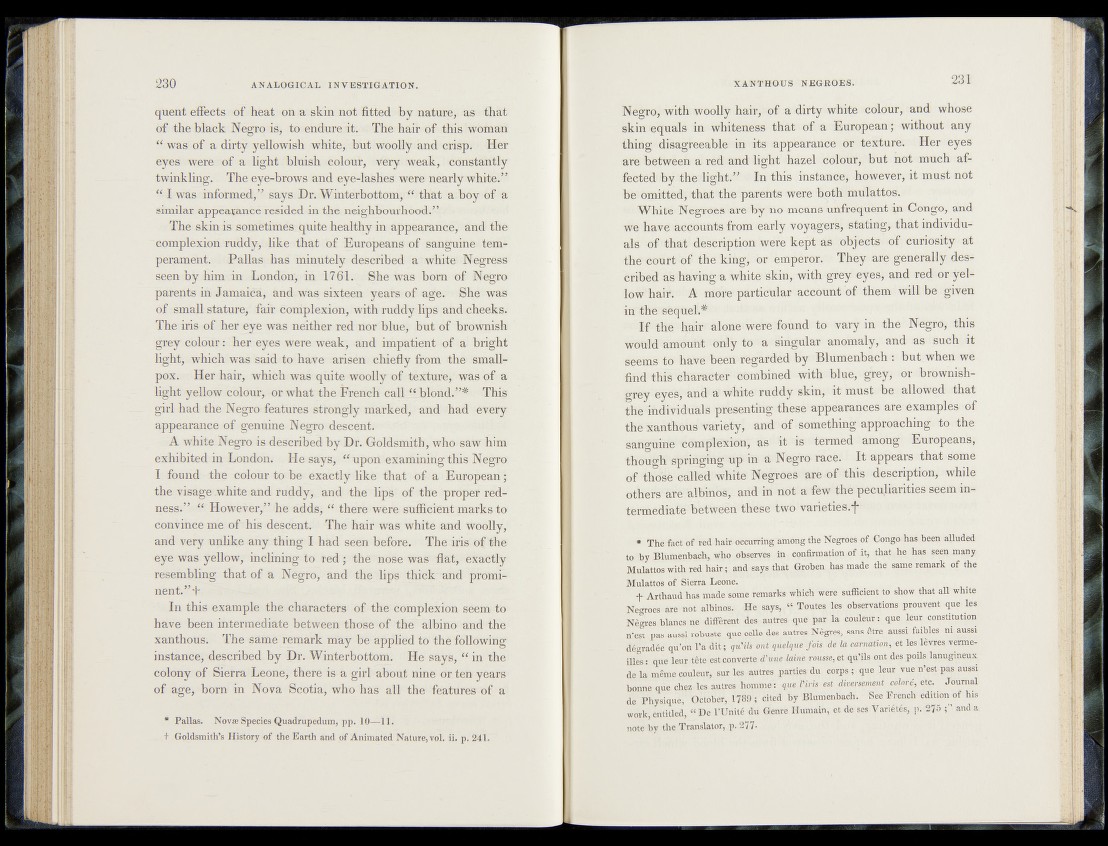
quent effects of heat on a skin not fitted by nature, as that
Of the black Negro is, to;«hdoredtv The hair of thisf woman
‘‘was of a dirty yellowish white, but woolly and crisp* Her
eyes were of a light bluish colour, very weak, constantly
twinkling. The eye-brows and eye-lashes were nearly white.”
“ I was informed,” says Dr. Winterbottom, “ that a boy Of a
similar appearance resided in the neighbourhood.”
The skin is sometimes quite healthy in appearance, and the
complexion ruddy, like that of Europeans of sanguine temperament.
Pallas has minutely described a white Negress
seen by him in London, in 1761. She was born of Negro
parents in Jamaica, and was sixteen years of age. She was
of small stature, fair complexion, with ruddy lips and cheeks.
The iris of her eye was neither red nor blue, but Of brownish
grey colour: her eyes were weak, and impatient of a bright
light, which was said to have arisen chiefly from the smallpox.
Her hair, which was quite woolly of texture, was of a
light-yellow colour,^or what the French cafflLblóÉÉ/’* This
girl had the Negro features strongly marked, and had every
appearance of genuine Negro descent.
A white Negro is described by Dr. Goldsmith, who saw him
exhibited in London. He says, “ upon examining this Negro
1 found the colour to be exactly like that of a European;
the visage white and ruddy, and the lips of the proper redness.”
“ However,” he adds, “ there were sufficient marks to
convince me o f his descents The hair Was white and Woolly^
and very unlike any thing I had seen before. The iris of'the
eye was yellow, inclining to re d ; the nose was flat, exactly
resembling that of a Negro, and the lips thick 'and prominent.”
+• £
In this example the characters of the complexion seem to
have been intermediate between those of the albino and the
xanthous. The same remark may be applied to the following
instance, described by Dr. Winterbottom. He says, “ in the
colony of Sierra Leone, there is a girl about nine or ten years
of age, bom in Nova Scotia, who has all the features of a
• Pallas. Nova Species Quadrupedum, pp. 10—11.
f Goldsmith’s History of the Earth and of Animated Nature, vol. ii. p. 241.
Negro, with woolly hair, of a dirty white colour, and whose
skin equals in whiteness that of a European; without any
thing disagreeable in its appearance o r texture. Her eyes
are between a red and light hazel colour, but hot much affected
by the -light.” In this instance, however, it must not
be omitted, that the parents were both mulattos.
■ White Negroes are’fey-ho means unfrequent in Congo, and
we have accounts from early voyager's; stating^ that individuals
of that description were kept as objects-, of curiosity at
the court of the king, or empèror. They are generally described
as having a white skin, witb'g»ey; eyes; ■ and red or yellow1
hair. A more particular .account of them will be given
in the'sèqüeli*
If-fhe hairs' aloneJ were ffoiknd Ê || vary in th e : Negro, this
would amount only to a singular' anomaly, and as such it
seems to havé been regarded by' Blumenbach : b u t when we
find thii^harafet'er:f Cbmbined with blue,- '^ey> h r hrowkish-
grey hyés'fteib a white ruddy skin, Jit mustsffie allowed that
the individual s presenting these appearances- aréoèxampl es*of
the xanfhouS varietyj and öf - something approachin^lqtthe
sanghihe icdmplexion, as it is i termed among' Europeans^
though springihg up in a Negro race. It appears that some
of thbsè called-white Në^röès .are o f this description^ while
others'are albinos; and in not a few the peculiarities seem in-
termediater;between these'fwb varieties."!*
* The fact of! red hair- oecurring'among the Negroes of Congo-has beeir aUuded
to by Blumenbach, who observes in confirmation ^ f it; t h a t h a s seen many
Mulattos with red Hair ; and says that Groben has made the* same remark of the
Mulattos of Sierra Leone.
*b Arthaud has made some remarks which were sufficient to show that all white
Negroes are not albinos. He says, É Toutes les observations prouvent ,qtte: les
Nègres blancs ne diffèrent des autr'es que par ld couleur i] ^ / ^ » » ^ ^ | t i o n
n’est pas aussi robuste que eelle des autres Nègres, sans être aussi-faibles ni aussi
dégradée qu’on l’a dit; qn'iÛ W f quelque 'fois'rke la carnation, et les lèvres vermeilles
: que leur tête est converte d’üne laine rousse, et qu’ils ont des poils lanugineux
de la même couleur,, sur les autres .parties du corps ; que leur vue n’est pa§ aussi
bonne que chfz les autres homme': Journal
de Physique; 'October, 1789'; Cited Bjr Blumenbach. 'See French edition- of his
work, entitled, « De l ’Unité du Genre Humain, et de ses Variétés, p. 275 .and a.
note by the Translator, p. 277*